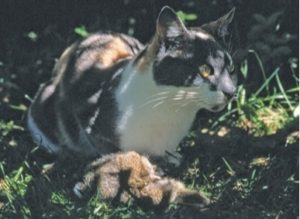
Peng You with her favourite prey – rabbit
Cats are fascinating to watch. But not many pet owners take cat-watching as far as Dr John Flux has. John observed his cat Peng You closely and recorded a great deal about her behaviour.
In particular he observed and recorded her hunting behaviour – what she caught, how and when, and how much of her prey she ate.
These observations extended over the whole of Peng You’s 17-year life and have now been published as a scientific article in the New Zealand Journal of Zoology. This article is a truly fascinating read. Who would have thought that we could learn so much about our environment and the interaction of the animal species in it from watching a cat?
John Flux is a professional zoologist with a particular interest in ecology so he brings a lot more expertise to bear on this than most of us. He is an advocate of low key research based on careful observation and recording. Peng You’s story tells us that we could all learn a lot more from our cats.
John and his wife Meg got Peng You as a kitten from the wild and reared her using prey as part of her diet. They have a large 0.5 hectare section in Belmont, on the fringe of Lower Hutt. Flanked by a mature pine plantation on one side and pony paddocks on another, it would seem to be paradise for a hunting cat. And indeed it was.
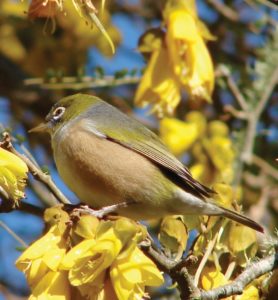
Birds – like this Silvereye – formed part of Peng You’s hunting prey, but her activities appeared to make no impact on the abundance of birds in the garden.
Over the next 17 years Peng You brought home 558 prey items. These included 221 mice, 63 rats, 35 rabbits, four hares and two weasels. Peng You also brought in 223 birds. Of the 54 native birds brought in 43 were silvereyes (waxeyes), a species which migrated from Australia about 150 years ago. There were also five fantails, four warblers, a kingfisher and a shining cuckoo. Nine skinks and a frog made up the balance.
These kills appeared to make no impact on the abundance of birds and reptiles in the garden even among the hedge sparrows and silvereyes that were Peng You’s most common avian prey. In fact some new bird species moved into Peng You’s hunting area over her lifetime. These included welcome swallows, plover, tui and kereru. The tui and kereru may have been encouraged by an increase in native vegetation over the 17 years.
Only the rabbit population showed a marked change. Peng You quickly eliminated the five pairs of rabbits occupying separate burrows in the garden within her first year and continued to catch rabbits on surrounding land till she was seventeen. Rabbits did not return to the garden till four months after her death.
Except for silvereyes, native birds such as fantails and warblers, which are relatively tame and were present throughout the year, were rarely caught. This is consistent with David Mudge’s five year video surveillance of 400 fantail nests which found ‘that fantail breeding success is much greater when nests are near houses where there are cats, especially when rat numbers are high’. Peng You didn’t bother the free range hens or their chicks that were kept on the property.
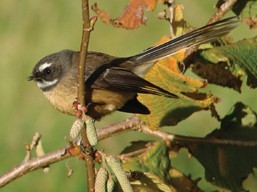
Fantail populations do better when cats get rid of their rodent predators
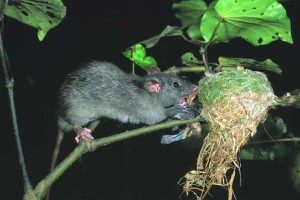
Rat raiding bird nest
The effect on the reptile population was low. Peng You only caught nine copper skinks in her lifetime, playing with them as she would a mouse. This was less than the number of skinks that the sole kingfisher she caught might eat in one week! It may be that Peng You just didn’t like skinks. Other Wellington studies have recorded a much higher percentage of reptiles caught, though the ratio of birds to rodents caught was very similar.
It certainly appears that Peng You hunted for enjoyment. She was fed ad lib twice a day throughout her life, and so was never hungry. She clearly preferred the taste of some prey and appeared to selectively hunt some bird species. Hedgesparrows (dunnock) were caught much more often than the more available housesparrows, and Peng You would eat a much greater proportion of the hedgesparrow carcase, suggesting a taste preference.
John Flux suggests that Peng You was ‘farming’ some of the prey in her environment. He bases that comment on her behaviour in preferring to let nestlings grow to fledgling size before taking them, and says she seemed to harvest young rabbits from surrounding burrows which still maintained breeding rabbits over 25 years.
Peng You’s hunting peaked between the ages of three and seven, when she averaged 60 kills per year. Between ages eight to twelve she averaged just 15 kills a year, and only five a year in her old age. She continued to catch a similar proportion of birds and mammals, though only one native bird was caught after the age of nine. She continued to catch rabbits at about the same rate through to age sixteen, perhaps because catching rabbits requires more patience than agility. They were also her favourite food and she would typically eat the whole rabbit except for its skin and the hindfeet.
It was in her hunting prime that she caught two weasels. Quite a feat, since an intensive trapping program in the adjacent Belmont Regional Park failed to catch any!
John suggests that cats are highly efficient samplers of their environment. Peng You once brought a full grown green frog into the house, though none had ever been seen or heard in the garden, in which there is no pond. Peng You dropped the frog and continued to froth at the mouth for some time. Their current cat has caught a gecko, the first ever recorded for the area.
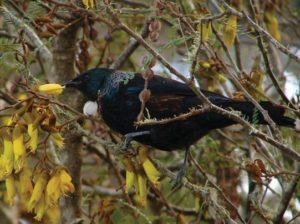
Tui moved into Peng You’s hunting area over her lifetime,
possibly attracted by the increasing native vegetation, but she was never known to have caught one.
I asked John whether cats were good or bad in NZ ecosystems. “There is no clear answer,” he replied. “They are certainly bad on rodent-free offshore islands. But they are probably okay in NZ bush since, on balance, their positive effect in suppressing rodents far outweighs their negative effects on bird predation.”
Peng You lived in an urban fringe ecosystem and John quotes a number of other studies to support his contention that keeping cats indoors at night is the completely wrong thing to do if we want to protect birdlife in our towns and cities. Cats catch rodents rather than birds at night and rodents are a bigger threat to birds.
He offers this final quote from a British researcher. “Cats have a great advantage over human beings in the control of rat populations at a very low level: they do not seem to get bored!”
“Keeping cats indoors at night is the completely wrong thing to do if we want to protect birdlife in our towns and cities.”
This article written by Hans Andersen was first published in Paws for thought magazine in 2009. Images supplied for that article by Dr John Flux

Recent Comments